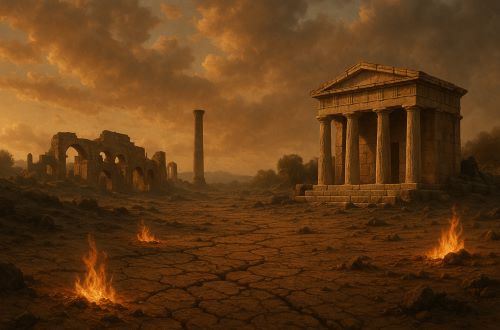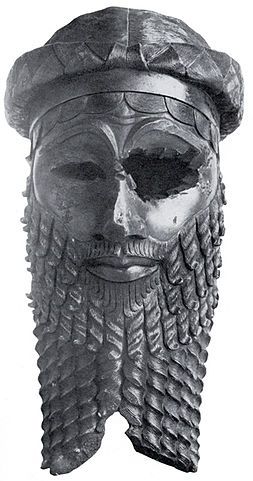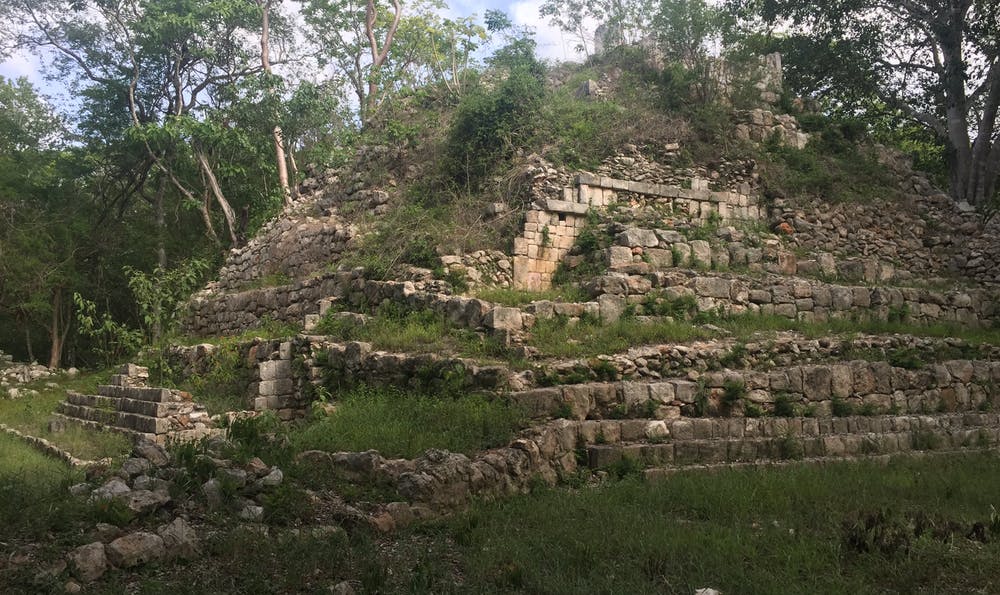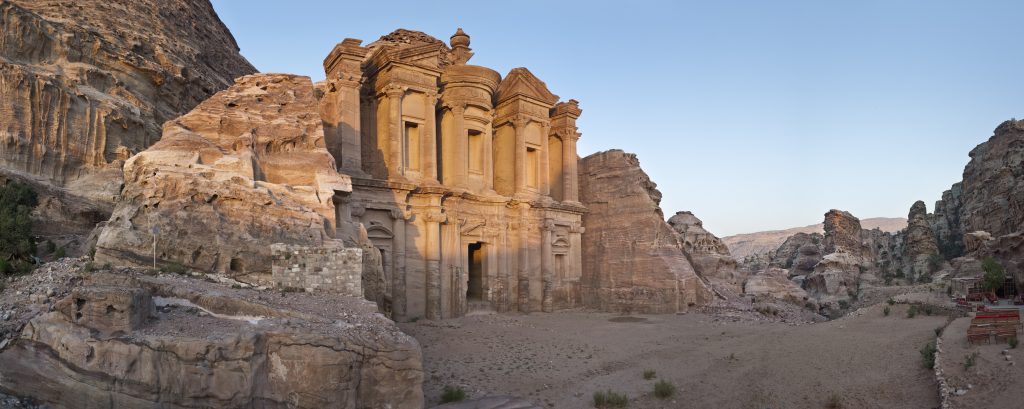

The stories of Akkad, the Maya, and Rome offer more than cautionary tales; they offer insight into the deep interdependence of nature and civilization.

By Matthew A. McIntosh
Public Historian
Brewminate
Introduction: Fragile Orders in Shifting Skies
Civilization, for all its achievements in architecture, writing, and warfare, has always lived on borrowed time from the weather. Beneath the vaulted temples of Mesopotamia and the stone causeways of the Maya, beneath the state ideologies and imperial ambitions, lay something far more precarious: dependence on seasonal rains, fertile soil, and relatively stable patterns of temperature and precipitation.
We tend to narrate the fall of ancient empires through the lens of conquest or political mismanagement: Caesar crosses the Rubicon, Babylon falls to Persia, dynasties lose the Mandate of Heaven. But climate, that vast and ambivalent force, lurks in the margins of these stories, often ignored or romanticized. And yet, extreme weather, drought, or sudden ecological shifts frequently played decisive roles in the unraveling of complex societies.
This essay explores how ancient civilizations faced, or failed to face, dramatic climate shifts. It is not an attempt to flatten history into a deterministic arc of environmental cause and effect. Rather, it argues that climate was one powerful variable among many, made decisive by how societies chose, or were able, to respond. In this, the ancient world offers a mirror for our own age of ecological disruption, political inertia, and infrastructure under strain.
The Akkadian Collapse and the Desiccated North

The Akkadian Empire, founded by Sargon the Great around 2334 BCE, is often considered the world’s first empire, an early experiment in administrative centralization, road building, and cross-cultural integration. It was also, like most Mesopotamian polities, acutely vulnerable to the rain-fed agriculture of the northern plains.
Around 2200 BCE, that vulnerability became catastrophic. Archaeological and geological evidence suggests that a prolonged, severe drought struck the region during this time, commonly referred to as the “4.2 kiloyear event.” Sediment cores from Tell Leilan in Syria show signs of rapid aridification and abandonment during this period.1 Clay tablets describe crop failure, famine, and social breakdown, refracted through the lens of religious lament.2
Scholars debate whether the drought was the root cause of the empire’s fall, or merely an accelerant to existing tensions.3 But what remains clear is this: the empire, in its rigidity and reliance on centralized provisioning, lacked the flexibility to endure a prolonged ecological crisis. The drought did not merely parch the land; it fractured the imperial imagination.
“May the fields bear no grain, may the sheep bear no lambs…” — Lament for Ur
The Maya Collapse: Rain, Kingship, and Water Management

In the limestone lowlands of the Yucatán Peninsula, the Classic Maya flourished for centuries with sophisticated city-states, elaborate ritual calendars, and monumental architecture. But by the end of the 9th century CE, major urban centers like Copán, Tikal, and Palenque were in steep decline.
Paleoclimate data from lake sediment cores and stalagmites point to a sustained period of drought, especially between 800 and 1000 CE.4 These dry decades would have devastated rain-fed crops, strained water storage systems, and undermined the ceremonial role of kings as intermediaries with the gods.
Unlike the Akkadians, the Maya were not a single empire, but a constellation of competing polities. Yet a shared cosmology linked rainfall to kingship and ritual practice. When the skies failed, so too did royal legitimacy. Inscriptions stopped. Cities were abandoned. The collapse was not uniform, but widespread and culturally resonant.5
As scholars have noted, the fall of Maya cities reveals a broader truth: ecological crisis becomes civilizational collapse only when adaptation fails, whether due to political rigidity, elite competition, or cultural constraints.6
The Fall of the Roman West: A Climate Tapestry, Not a Trigger

The decline of the Western Roman Empire has long resisted tidy explanations. Military overreach, corruption, barbarian incursions. All are familiar culprits. Yet in recent years, environmental historians have added another layer: the role of climate volatility in Late Antiquity.
Tree-ring studies and glacier ice cores indicate a pattern of cooling and climatic instability beginning in the 4th century CE.7 This “Late Antique Little Ice Age,” coupled with volcanic eruptions in the 530s and 540s, precipitated widespread crop failures, social unrest, and disease, notably the Justinian Plague of 541 CE.8
While the Eastern Roman (Byzantine) Empire endured these stresses through institutional adaptation, the West (fragmented and economically hollowed) proved more vulnerable. Climate did not cause the fall of Rome in a mechanistic sense, but it shaped the context in which collapse occurred.9
As Kyle Harper has argued, the Roman world was not merely conquered, it was slowly undone by “the unrelenting pressure of natural forces.”10
Adaptation and Infrastructure: Winners in the Ruins

Not all responses to environmental stress ended in disaster. The Nabataeans of Petra mastered desert hydrology, channeling flash floods and storing water in cisterns carved into rock.11 The Inca of the Andes terraced mountains and built storehouses to buffer against variable climate conditions.12 Even post-collapse Maya communities persisted in smaller, dispersed forms.
What distinguished resilient systems was not technological superiority, but social and political flexibility, the ability to pivot, redistribute, and rethink collective priorities. Resilience, in this sense, was not just an outcome but a cultural capacity.
Infrastructure is not neutral. It encodes priorities, assumptions, and limits. The ancients who survived environmental crises did so not by conquering nature, but by cooperating with it. This is a lesson we’ve largely forgotten.
Climate Then and Now: From Collapse to Paralysis
Modern civilization, for all its complexity and computational power, is still governed by weather and water. But unlike the ancients, we possess models, warnings, and foresight. What we lack is not knowledge, but coordination.
Our current infrastructure, from global supply chains to electric grids, is vulnerable in much the same way as the canal-fed systems of Mesopotamia or the ceremonial rain-making kings of the Maya. The crisis is no longer theoretical: fires, floods, and famines now appear in the headlines with grim regularity.
The true parallel with the ancient world lies in our failure to act. Political polarization, economic short-termism, and cultural denialism have produced paralysis where resilience is needed most.13
Conclusion: Memory in the Ruins
History doesn’t repeat, but it rhymes. The stories of Akkad, the Maya, and Rome offer more than cautionary tales; they offer insight into the deep interdependence of nature and civilization. Collapse is not inevitable, but it is always a possibility when warning signs go unheeded.
We do not lack technology. We lack imagination, solidarity, and the moral will to build systems that endure.
The ancients could plead ignorance. We cannot.
Appendix
Footnotes
- Harvey Weiss and Raymond S. Bradley, “What Drives Societal Collapse?” Science 291, no. 5504 (2001): 609–610.
- Sing C. Chew, World Ecological Degradation: Accumulation, Urbanization, and Deforestation, 3000 BC–AD 2000 (Walnut Creek: AltaMira Press, 2001), 40.
- Ibid., 43.
- David D. Zhang et al., “The Causality Analysis of Climate Change and Large-Scale Human Crisis,” PNAS 108, no. 42 (2011): 17296–17301.
- Nicholas P. Dunning et al., “Ancient Maya Reservoirs, Constructed Wetlands, and a Mechanism for Sustainable Water Management,” PNAS 109, no. 10 (2012): 3646–3651.
- Fikret Berkes, Johan Colding, and Carl Folke, Navigating Social-Ecological Systems: Building Resilience for Complexity and Change (Cambridge: Cambridge University Press, 2003), 8–11.
- Kyle Harper, The Fate of Rome: Climate, Disease, and the End of an Empire (Princeton: Princeton University Press, 2017), 26.
- Ibid., 134–40.
- Ibid., 212–220.
- Harper, Fate of Rome, 8.
- Chew, World Ecological Degradation, 94.
- Berkes, Colding, and Folke, Navigating Social-Ecological Systems, 101.
- Harper, Fate of Rome, 247.
Bibliography
- Berkes, Fikret, Johan Colding, and Carl Folke. Navigating Social-Ecological Systems: Building Resilience for Complexity and Change. Cambridge: Cambridge University Press, 2003.
- Chew, Sing C. World Ecological Degradation: Accumulation, Urbanization, and Deforestation, 3000 BC–AD 2000. Walnut Creek: AltaMira Press, 2001.
- Dunning, Nicholas P., et al. “Ancient Maya Reservoirs, Constructed Wetlands, and a Mechanism for Sustainable Water Management.” Proceedings of the National Academy of Sciences 109, no. 10 (2012): 3646–3651.
- Harper, Kyle. The Fate of Rome: Climate, Disease, and the End of an Empire. Princeton: Princeton University Press, 2017.
- Weiss, Harvey, and Raymond S. Bradley. “What Drives Societal Collapse?” Science 291, no. 5504 (2001): 609–610.
- Zhang, David D., et al. “The Causality Analysis of Climate Change and Large-Scale Human Crisis.” Proceedings of the National Academy of Sciences 108, no. 42 (2011): 17296–17301.
Originally published by Brewminate, 07.14.2025, under the terms of a Creative Commons Attribution-NonCommercial-NoDerivatives 4.0 International license.


